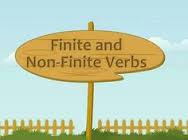If the negative for the term “true finite verb” doesn’t ring a bell to you and to many other people, it’s because the more commonly used term for it is “non-finite verb.” Of course, this abstract term itself is not self-explanatory and needs to be explained.
A
true finite verb is one where the verb shows tense, person, and number (either singular or plural). It either describes an action or expresses a state of being, and can stand by itself as the main verb of a sentence. Examples of finite verb forms: “I
sing.” “He
sings.” “We
sang.” (These are actions taken.) “I
am happy.” “She
was happy.” “They
were happy.” (This is a state of being using different forms of the linking verb “be.”)
A
non-finite verb, in contrast, is one where the verb assumes a form without tense or person. They are what we know as the
verbals: the
infinitives,
gerunds, and the
present or past participles. In these forms, the verbs no longer function as verbs; they function either as nouns or adjectives. As nouns they are always singular in number; as adjectives, of course, they have no number at all.

Consider the following examples of verbals:
Infinitive form: “
To eat is not advisable now.” In this sentence, “to eat” is a noun functioning as the subject of the sentence.
Gerund form: “
Eating is not advisable.” In this sentence, “eating” is a noun functioning as the subject of the sentence. Of course, a gerund can sometimes also be the doer of the action in a sentence, as in “
Eating makes the patient sick.”
Participle form: Past participle – “The
eaten apple was not a fresh one.” In this sentence, the past participle “eaten” is functioning as an adjective modifying “apple.”
Present participle – “The
eating competition drew a lot of participants.” In this sentence, the present participle “eating” is functioning as an adjective modifying “competition.”
Now we can answer this crucial question:
What’s the point of using the qualifier “true” in describing certain “finite verbs”? It is this: One of the verb forms, the one that ends in “-ing,” can either be “true finite verb” or a “non-finite verb” depending on the usage. It’s a true finite verb when used in the progressive tense, as in “He
is preaching environmentalism.” (Here, “preaching” works as a verb in the progressive tense supported by the auxiliary verb “is.”) On the other hand, it is non-finite when used as a gerund, as in “
Preaching is what he does right now.” (Here, preaching is a noun working as the subject of the sentence.)
In other words, a verb is a true finite verb when it’s actually doing its usual work as a verb, and a non-finite verb when it’s working as something else—either as a noun or as an adjective.